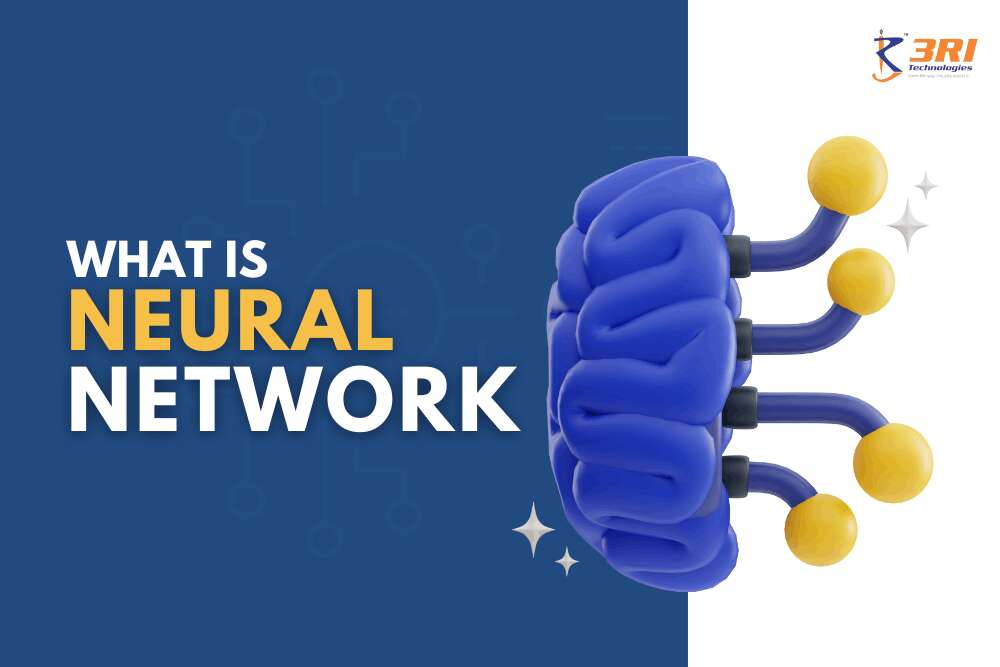The phrase “neural network” refers to a subclass of artificial intelligence that attempts to mimic brain structure and behavior biologically. By “neural network,” most people mean a computer network designed to work similarly to the biological neural networks found in the human brain. Like neurons in the human brain, the neurons in artificial neural networks are connected across multiple levels of the network. A node is a specialized form of the neuron.
This tutorial on neural networks explains everything about artificial neural networks. In this lesson, we’ll talk about everything there is to know about neural networks, like what is neural network and what is a convolutional neural network among other things.

Want Free Career Counseling?
Just fill in your details, and one of our expert will call you !
What Is A Neural Network?
Deep learning techniques, a branch of machine learning, are predicated on using ANNs and SNNs. The human brain inspires their architecture, and their purpose is to mimic how organic neurons communicate.
An ANN consists of three distinct node layers: input, hidden layer(s), and output. There is a weight and a threshold associated with each artificial neuron in the network. If a node’s output is above a certain point, then the node will be activated in the subsequent network layer. Data is sent to the following network layer when this criterion is satisfied.
Neural networks can learn and develop through repeated exposure to training material. These learning algorithms make the quick classification and clustering of data possible once they have been fine-tuned for accuracy. Speech and image recognition technologies can finish jobs that would take human professionals hours to identify in a matter of minutes. The neural network used in Google’s search algorithm is a famous example of this type of system.
Now you know what is the neural network, let’s move on.

History of neural networks
Contrary to common opinion, neural networks have existed for a far longer time. We’ll focus on the crucial moments that affected the evolution of thinking about neural networks, whose popularity has changed over time, even if the idea of “a machine that thinks” can be dated to the Ancient Greeks:
Warren McCulloch and Walter Pitts’ “A Logical Calculus of the Ideas Immanent in Nervous Activity” from the 1943 publication, Universities of Illinois and Chicago. The study looked at how the brain might produce complex patterns while being reduced to a straightforward binary logic system with only true/false connections.
Frank Rosenblatt of the Cornell Aeronautical Laboratory invented the perceptron in 1958. Rosenblatt utilized his research to demonstrate how neural networks may be used by computers to detect images and draw conclusions, adding weight to the work of McColloch and Pitt.
following a research pause in the 1970s, which was partially caused by a financial lull. Then, in 1982, a paper on recurrent neural networks by Jon Hopfield, dubbed Hopfield Net, was released. In addition, the concept of backpropagation was revived, and many researchers saw how useful it could be for neural networks. Paul Werbos frequently receives credit for being the primary contributor at this time in his PhD thesis.
More focused neural network projects are currently being created for immediate purposes. IBM’s Deep Blue, for instance, revolutionized chess by pushing the limits of computers’ capacity for intricate math. Although these machines are most known for their ability to defeat the world chess champion, they are also used to develop new medicines, identify financial market trends, and carry out extensive scientific calculations.
What Makes Neural Networks So Important?
Neural networks enable computers to make wise decisions with little human input.
They are better at learning and modeling links between input and output data that are not simple or linear. For instance, they are capable of doing the following jobs.
- Make generalizations and Inferences
Without prior instruction, neural networks can understand unstructured material and make generalized assessments. For example, they can distinguish between two input sentences with identical meanings.
- Could you describe the payment procedure?
- How do I transfer funds?
A neural network would use both words to mean the same thing. It may also be aware that Baxter Smith is a name and that Baxter Road is a location.
Looking forward to becoming an expert in Data Science? Then get certified with Data Science And Machine Learning Course.
For What Purposes Are Neural Networks Used?
There are numerous applications for neural networks in multiple industries, including the following:
- Medical picture categorization for diagnosis
- Analysis of behavior data and filtering of social networks for focused marketing
- Using info from past financial instruments to make predictions about the economy
- Trying to predict how much electricity and energy will be used
- Procedures and quality are under control.
- Finding out what a chemistry compound is
We list four significant neural network applications below.
1.Computer Vision
Computer vision is the capacity of computers to learn from pictures and videos and get knowledge and ideas from them. With neural networks, computers can tell the difference between and identify images as people can. Several things can be done with computer vision, such as:
- Autonomous vehicles with visual recognition technology can read road signs and avoid collisions.
- Automatic filtering of media libraries for potentially harmful or offensive material
- Recognition of faces based on facial features such as the presence or absence of hair, glasses, and open eyes
- Image labeling to identify company logos, clothing items, and safety equipment
2. Speech Acknowledgment
Neural networks can understand human speech regardless of speaker, language, accent, or pitch variation.Speech recognition is a feature of automatic transcribing software and virtual assistants like Amazon Alexa.
- Classifying calls instantly can help the people who work in the call center.
- Transcription of professional conversations into written notes in real-time
- Caption movies and meeting videos correctly to make them more accessible.
SkyRocket your career with our course Data Engineering Training with Placement
3. Normalized Language Processing
NLP, or natural language processing, is the capacity to work with human-written language. Neural networks help computers determine what text data and papers mean and what they mean. NLP can be used in several situations, such as:
- Chatbots and automated virtual agents
- Automatic data classification and organization
- Long-form papers like emails and forms are looked at by business intelligence.
- Indexing important words and phrases that show how people feel, like positive and negative comments on social media
- Creation of articles and document summaries for a specific subject
4. Engine Recommendations
Neural networks can monitor user behavior and generate customized recommendations. They can employ user behavior analysis to find novel goods and services that their intended market will likely find appealing. Curalate, a startup out of Philadelphia, helps big businesses turn their social media activity into sales. The intelligent product naming (IPT) service from Curalate automates the gathering and organization of user-generated social information for businesses.
Neural networks are used by In-Page Tailoring (IPT) to find and suggest products relevant to a user’s social media activity. If consumers see a product they like on social media, they don’t have to scour the web for it. Instead, consumers can utilize the automatic product tagging provided by Curalate to make the purchase process a breeze.
Become a PRO Data Analyst with Data Analyst Course in Pune
Application of Neural Networks
Numerous businesses, including trading, business analytics, financial operations, corporate planning, and product maintenance, use neural networks. Business applications like forecasting and marketing research tools, fraud detection, and risk assessment are increasingly using neural networks.
In order to identify trading opportunities based on the analysis of the data, a neural network analyzes price data. Traditional technical analysis techniques cannot see interdependencies and subtle nonlinear patterns that the networks can. According to a study, neural networks’ accuracy in predicting stock prices differs. Some models accurately forecast stock prices 50%–60% of the time, while others succeed 70% of the time. Some assert that a 10% gain in efficiency is the maximum an investor can anticipate from a neural network.
Tens of thousands of bits of transaction data, notably in banking, can be processed using neural networks. Better understanding of trade volume, trading range, asset correlation, or identifying the level of volatility to be anticipated for specific assets may result from this. In order to quickly sort through years’ worth of data (sometimes obtained at second intervals), neural networks can be used to find trends, analyze outcomes, and estimate future changes in the value of an asset class.
How to train neural networks?
Deep learning techniques are built on neural networks, often known as artificial neural networks (ANNs) or simulated neural networks (SNNs). They mimic how actual neurons communicate by using a structure and vocabulary that are modeled after the human brain.
The process of instructing a neural network to carry out a task is known as neural network training. In the beginning, neural networks process numerous sizable sets of tagged or unlabeled data. They can then more precisely process unknown inputs by leveraging these examples.
Supervised learning
In supervised learning, artificial neural networks that already know the answer are fed labeled datasets. A deep learning network that has been trained in facial recognition, for instance, first examines hundreds of thousands of images of human faces and labels each one with phrases that designate the location, ethnicity, and mood.
These datasets, which contain solutions previously known, allow the neural network to gradually accumulate knowledge. After training, the network starts making assumptions about the ethnicity or emotion of brand-new human face photos.
Multi-Layered Perceptron-
In 1958, Frank Rosenblatt developed the perceptron, the first neural network. We have primarily discussed feedforward neural networks, also referred to as multi-layer perceptrons (MLPs), in this article. An input layer, a hidden layer, and an output layer make them up. These neural networks, also known as MLPs, use sigmoid neurons rather than perceptrons since the majority of real-world problems are nonlinear. These models serve as the basis for neural networks used in computer vision, natural language processing, and other fields. Typically, data is sent into them to train them.
A multi-layered perceptron (MLP) is made up of interconnected layers of perceptrons. The input layer collects input patterns. In the output layer, input patterns may be converted to classifications or output signals. The patterns could include a list of amounts for technical indicators about a security, for example; possible outputs include “buy,” “hold,” or “sell.”
The input weightings are changed in the hidden layers of the neural network to lower the error margin as much as is practical. It is believed that hidden layers extract significant elements from the input data that have the capacity to predict the outputs. This article addresses feature extraction, a statistical technique that serves a similar purpose to principal component analysis.
How Do Neural Networks Function?
The structure of neural networks is influenced by how the human brain works. Electrical signals are exchanged between the neurons that make up the human brain to facilitate information interpretation. A similar artificial neural network that solves problems is constructed using artificial neurons. Software programs or algorithms known as artificial neural networks use computational infrastructure to perform mathematical calculations. Software nodes, also referred to as artificial neurons, are software components.
Simple Neural Network Architecture
A primary neural network is made up of three layers of artificial neurons that are all linked to each other:
1.Input Layer
The input layer of a neural network made of artificial neurons receives data from the outside environment. Before sending data to the layer below, input nodes process, evaluate, or classify the data.
2. Hidden Layer
A hidden layer might get information from the input or another hidden layer. Artificial neural networks could include many undisclosed layers. Each hidden layer assesses the output of the layer below it, does some post-processing, and then passes it on.
3. Output Layer
The output layer must deliver the artificial neural network’s ultimate output. There could be a single node or several. A neural network trained to handle binary (yes/no) classification problems has one node in its output layer, which can only provide a value of 1 or 0. The output layer, however, could have many nodes if there are numerous classes to go through.
Check out the Data Science online training and get certified today.
Architecture of Deep Neural Networks
Millions of artificial neurons are connected in numerous buried layers of deep neural networks, also known as deep learning networks. A weight, a numeric value, represents each connection between nodes. When one node stimulates while another is repressed, the weight is positive. A node’s ability to influence other nodes grows in proportion to the sum of its weight values.
Deep neural networks can convert all possible input to any potential output. They need a lot more practice than other types of machine learning. Training data samples in the millions are required instead of the hundreds or thousands that a less complex network could need.

Meet the industry person, to clear your doubts !
What Kinds of Neural Networks are There?
The data flow from an artificial network’s input node to its output node can be used to classify the network. Some examples are as follows:
1. Feed-Forward Neural Networks
The feed-forward network is straightforward to comprehend and use. Information is processed and sent linearly from the input nodes to the output mode. Feed-forward neural networks are often used in face recognition systems, and these networks may have hidden layers.
2. Recurrent Neural Networks
Recurrent neural networks are a more advanced type of neural network. They take a processing node’s output and recirculate it around the network. This leads to the network “learning” and improving, at least in theory. Each node keeps track of past processes, and these past processes are used again in the future when the node is being processed.
This is crucial because when a prediction comes true, the system will strive to understand why it did it and adjust its behavior accordingly. This neural network is frequently employed in apps that turn text into sounds.
3. Convolutional Neural Networks
Convolutional neural networks, or CNNs or ConvNets, contain multiple layers of categorizing data. These networks consist of input, output, and many concealed convolutional layers. The layers make feature maps and records of parts of a picture that can be broken down further to make valuable outputs. These layers can be combined or linked all the way through, and these networks are beneficial for applications that need to recognize images.
4. Deconvolutional Neural Networks
Deconvolutional neural networks are just like convolutional neural networks that work backward. The purpose of the network is to find things that a convolutional neural network might have thought were important. While running the convolutional neural network, these things were likely thrown away. This neural network is also often used to process or analyze images.
5. Modular Neural Networks
Multiple independent networks combine to form modular neural networks. During the research process, these networks do not talk to each other. Instead, these steps are taken so complicated computer tasks can be done more quickly and easily. Like other modular industries, like modular real estate, the goal of network freedom is for each module to be in charge of a specific part of the bigger picture.
Interested to begin a career in Data Analytics? Enroll now for Data Analytics Course in Pune.

Book Your Time-slot for Counselling !
Pros and Cons of Neural Network
Pros of Neural Network :
Continually operating neutral networks are more efficient than either humans or simple analytical models. Additionally, by evaluating how much a future output resembles a previous input, neural networks can be taught to learn from past outcomes and make predictions.
The danger is reduced when comparing neural networks that use the cloud for internet services to those that depend on local technology hardware. Additionally, neural networks can frequently carry out numerous tasks simultaneously (or, at the very least, divide tasks to be carried out concurrently by modular networks).
Finally, neural networks are constantly being used for novel purposes. Although applying theoretical neural networks in many domains was previously severely restricted, neural networks are now used in various industries, including medicine, science, finance, agriculture, and security.
Cons of Neural Network :
Although neutral networks rely on online platforms, a hardware component is necessary to generate the neural network. This provides a physical danger for the network, which relies on complicated technologies, installation requirements, and probable physical upkeep.
Though neural network complexity is a strength, building a single algorithm for a specific task may take months (if not longer). Furthermore, detecting any flaws or faults in the procedure may be challenging, especially if the outcomes are estimations or theoretical ranges.
It is also possible that neural networks will be challenging to audit.Some neural network processes could resemble “black boxes,” in which input is provided, networks carry out intricate operations, and output is presented. Individuals may also find it challenging to examine flaws in the network’s computation or learning process if it lacks openness on how a model learns from earlier behavior.
If you wish to pursue a Data Science Course in Pune, then you can always drop by 3RI Technologies.
What is the Definition of Deep Learning in Relation to Neural Networks?
Artificial intelligence is a branch of computer science that focuses on building machines that can do activities that need human intelligence. Artificial intelligence, also known as machine learning, enables computers to access and learn from massive datasets. Software with machine learning analyzes historical data for patterns, then applies these patterns to new data to make prudent decisions. Deep neural networks are used in deep learning, a branch of machine learning, to process data.

Do you want to book a FREE Demo Session?
Machine learning vs. deep learning
Human input is necessary for conventional machine-learning approaches to work well. A data scientist manually selects the features that are essential and should be analyzed by the software. This limits the software’s capabilities and makes designing and managing it difficult.
In contrast, the data scientist supplies the algorithms with raw data in deep learning. The deep learning network grows into its characteristics and learns more independently. It can analyze text articles and other unstructured datasets, find the essential data features, and tackle more challenging problems.
For instance, to correctly train a machine learning program to recognize a picture of a pet, you would need to do the following:
- Discover and manually label thousands of pictures of cats, dogs, horses, hamsters, parrots, and other common household pets.
- Give the machine learning program a list of features to look for to eliminate possible solutions until it finds the correct one. It could count the number of legs, examine the eyes and ears, examine the tail and fur, and so on.
- The labelled datasets must be manually assessed and adjusted to increase the program’s accuracy. If the photographs in your training set are all black cats, the program will recognize a black cat but not a white cat.
- However, deep learning would evaluate all the photos and automatically determine that the number of legs and the shape of the face need to be analyzed first, followed by a look at the tails.
The Bottom Line
In conclusion, neural networks are complicated, interconnected systems that can do analytics much better and faster than people can. Different neural networks are often best for other tasks and goals. In finance, neural networks are employed to look at past transactions, determine how assets move, and predict what will happen in the financial market. Check 3RI Technologies for more job-oriented courses and to learn from experts.

